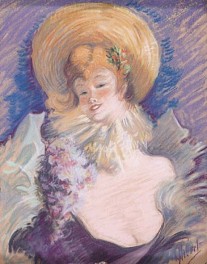BIOGRAPHY

1836 - 1932
Jules Cheret was born in Paris on May 31, 1836 in to a family of artisans. Since the family had little money, Jules Cheret’s formal education ended when at the age of 13, his family could no longer afford to keep him in school. His father, a typographer, placed Cheret in a three-year apprenticeship with a lithographer.
Although he was able to sell sketches to various music publishers in Paris, this did not satisfy Cheret. He left Paris for London in hopes of finding a more lucrative way to afford his career as an artist. After a short period of time executing drawings for The Maple Furniture Company, a frustrated Cheret, returned to Paris with no more money than when he began his journey.
In 1858 Cheret created his first poster for the composer Jacques Offenbach. Determined to continue his work as an artist, he designed book covers for the publishing firm of Cramer as well as several posters for the circus, theater, music halls, actresses and cabarets as well as products. Such advertisements were of a new kind, and these innovative and artistic efforts led him to the next phase of his work.
Through a good friend, Cheret was introduced to perfume manufacturer, Eugene Rimmel who gave the artist the opportunity to design for Rimmel‘s establishment. In 1866, in a bold and supportive move, Rimmel supported his protege Cheret in the establishment of a commercial color lithographic shop in Paris. As a result of this fortuitous relationship between Cheret and Rimmel, Cheret’s career was launched. Color lithography had never been done before and would now come to life under the mastery of Cheret in Paris.
First working in one or two colors, in 1869 Cheret introduced a new system of printing from three stones: one black, one red and the third a ‘fond gradué’ (graduated background, achieved by printing two colors from one stone, with cool colors at the top and warm colors at the bottom). This process was the basis of his color lithographic posters throughout the 1870s and early 1880s; he achieved what no other artist had done before.
His work showed delicate, powdery, and graceful fluidity of pastel and hues that contributed to the uniqueness and aesthetic finesse of his creative endeavors. Impressionists and Pointillists were absorbed and impressed with his "theory of complementary colors."
His works were not reproductions of drawings or paintings that already existed; these were truly original creations by Cheret. They were not colors printed one on top of the other, but rather colors separated and balanced, with each vibrant color unique and standing on its own in perfect harmony with the other colors; a symphony of color brilliantly orchestrated by Cheret. Cheret is credited with elevating lithography to an art form. His innovative color lithographic process would later be used by Henri de Toulouse-Lautrec.
In 1891 Lautrec created his first poster, "La Goulue" for the Moulin Rouge. Cheret fused modernity, innovation, established artistic quality, and commercial effectiveness in a mixture guaranteed to attract Paris’ attention utilizing the background of the Moulin Rouge. Cheret painted the iconic "Cherettes" and he was famous for these light-footed beauties.
He caused a revolution, a color revolution and there was fun and fantasy, glimpses of laughter, whirling of dancers decorating the kiosks of Paris, dazzling the senses and creating a movement of gaiety that had not existed before. His dancers came to life, these "Cherettes", light-footed, hedonistic nymphs beckoned you to come and share a night of frolic and fun at any one of a number of cabarets and theaters such as Alcazar d’ete, Musee Grevin, Eldorado, Olympia, Theatre de la Tour Eiffel, Follies Bergere, Theatre de l’Opera and The Moulin Rouge.
His vision failed him in 1925 yet this was a man who had an inner vision so brightly colored and alive that his loss of sight did not cause him to dwell in darkness. On September 23, 1932, he died at the age of ninety-six.
Cheret is considered to be The Master of the Poster.
